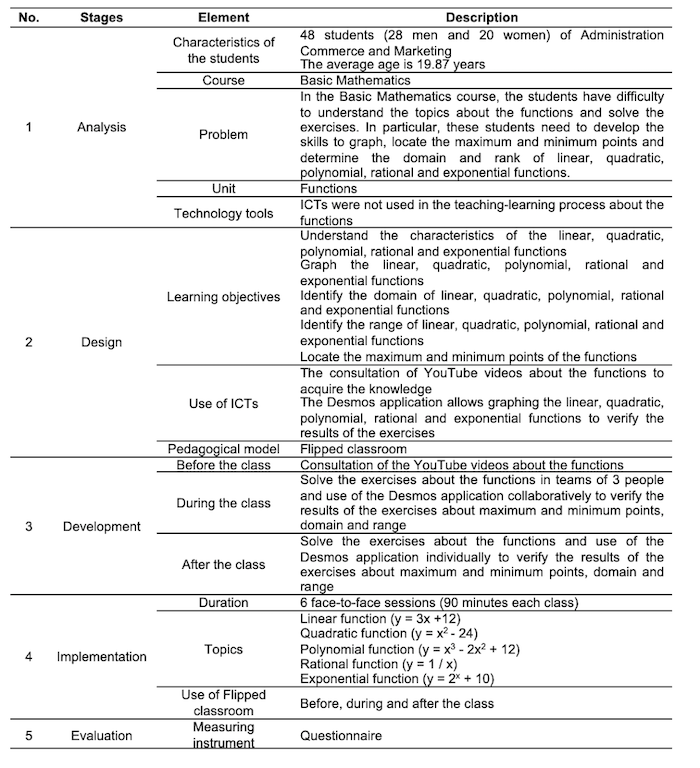
2023 VOL. 10, No. 3
Abstract: This quantitative research analyses the perception of students about the use of flipped classroom and technological tools in a Functions unit exploring machine learning algorithms on linear regression, a decision tree and neural networks. This research proposes consulting YouTube videos about functions and use of the Desmos application in the teaching-learning process. The results of the linear regression indicate that the consultation with YouTube videos before the class and use of the Desmos application collaboratively during the class, and individually after the class, positively influence the teaching-learning process on the functions. Likewise, the decision tree identifies three predictive models. The neural network establishes how the activities of this pedagogical model influence the teaching-learning process. The implications of this research suggest that universities update their courses and carry out creative school activities outside and inside the classroom through flipped classroom. Finally, the flipped classroom facilitates the active role of the students during the learning process, promotes the construction of new educational virtual spaces and allows for improving the educational process through the incorporation of technological tools before, after and during face-to-face sessions.
Keywords:flipped classroom, technology, higher education, data science.
Technological advances, such as Learning Management Systems (LMS) and mobile applications, are modifying pedagogical strategies (Sadik, 2021). In fact, young students have access to a wide variety of web applications, digital tools and audiovisual contents (Kamalova et al., 2021). For example, the incorporation of the Desmos application in the field of mathematics has facilitated learning about analytical geometry (Rojas-Maldonado, 2019). Educational institutions can improve teaching-learning conditions through the use of Information and Communication Technologies (ICTs) in school activities (Kadioglu et al., 2020; Long et al., 2019). For example, videos and web tools can be consulted by students at home and at school (Long et al., 2019). In the field of mathematics, students use YouTube videos to learn in a fun way under the distance modality (Insorio & Macandog, 2022). Data science uses machine learning algorithms to describe, analyse and evaluate educational phenomena (Muniasamy & Alasiry, 2020; Nehyba & Stefanik, 2023). According to Nehyba and Stefanik (2023), machine learning algorithms, such as the linear regression and decision tree, allow for a detailed analysis about the incorporation of technology in the educational field. For example, these algorithms facilitated the personalisation of the contents in the Learning Management Systems (Muniasamy & Alasiry, 2020). Nowadays, teachers seek to raise the quality of the learning process through the design, creation and use of pedagogical and technological models (Drozdikova-Zaripova & Sabirova, 2020). In particular, the flipped classroom is a pedagogical model where teachers share digital resources on the internet and perform active and collaborative activities during the face-to-face sessions (Drozdikova-Zaripova & Sabirova, 2020). Likewise, universities use this pedagogical model to restructure the teaching-learning environment and update the activities of the courses (Shih et al., 2019). The flipped classroom promotes the active role of the students through the performance of activities before, after and during the face-to-face sessions (Long et al., 2019). For example, students can consult videos before the face-to-face sessions to acquire the necessary knowledge (Djamaa, 2020). Also, teachers carry out collaborative activities with the support of technological tools in the classroom (Djamaa, 2020). Consequently, the flipped classroom facilitates the organisation of school activities, increases motivation, allows the construction of virtual spaces to learn and improves academic performance through technology (Sun et al., 2018).
Web applications and digital tools are modifying the functions, roles and behaviors of students during the teaching-learning process (Kadioglu et al., 2020). In the 21st century, new pedagogical models are emerging to improve educational practices and strategies (Sun et al., 2018). For example, the flipped classroom proposes the incorporation of ICTs during the realisation of school activities (Drozdikova-Zaripova & Sabirova, 2020).
The flipped classroom is a student-centered approach where participants take an active role inside and outside the classroom (Drozdikova-Zaripova & Sabirova, 2020). In fact, students analyse and use the contents of their courses at home through the use of technological tools and solve problems individually and collaboratively during the face-to-face sessions (Stratton et al., 2020).
According to Zainuddin and Halili (2016), the flipped classroom uses Bloom's Taxonomy to achieve student-centered learning, that is, students remember, interpret, understand, apply, analyse and evaluate the information of the courses. Also, students are able to construct new objects and elements during the realisation of the activities under this pedagogic model (Aydin et al., 2021). In particular, the use of web 2.0 tools in the field of education favours the active role of students, facilitates collaboration among participants and allows the realisation of school activities at any time (Aydin et al., 2021).
Also, the flipped classroom proposes consultation with audiovisual contents, realisation of online exams and revision of digital readings at home (Drozdikova-Zaripova & Sabirova, 2020). In fact, audiovisual contents, web applications, video conferencing systems and web 2.0 tools originated an increase in the use of this pedagogic model (Aydin et al., 2021).
During the flipped classroom, students have the possibility to learn at their own pace through consultation with videos, podcasts and readings (Altas & Mede, 2021). At home, students acquire an active role through the realisation of discussion forums and consultation with audiovisual contents such as readings, digital presentations and videos (Altas & Mede, 2021). Also, this pedagogic model improves the comprehension of topics through the realisation of creative activities during the face-to-face sessions (Altas & Mede, 2021).
Several authors (e.g., Cabi, 2018; Karabulut-Ilgu et al., 2018) have implemented the flipped classroom to improve teaching-learning conditions and build new educational spaces. In fact, this pedagogic model allowed the active role of the students in courses of English (Altas & Mede, 2021), Marketing (Shih & Tsai, 2017) and Health (Karabulut-Ilgu et al., 2018). For example, Cabi (2018) proposed the use of videos, didactic resources and Moodle to acquire knowledge of the topics at home. During the face-to-face sessions, the students performed their presentations collaboratively and actively participated in the Kahoot application (Cabi, 2018).
In the English course, the use of the flipped classroom facilitated the development of writing skills and increased academic performance (Altas & Mede, 2021). This pedagogic model transformed the educational process about the English language through the reviewing of videos at home and realising the collaborative activities in the classroom (Altas & Mede, 2021).
The flipped classroom seeks to improve teaching-learning conditions through the design and execution of school activities from anywhere (Long et al., 2019). In the Marketing course, Shih and Tsai (2017) implemented this pedagogic model through the incorporation of online questionnaires, SPSS software, presentations and discussion forums in the school activities.
In the Health course, the students consulted videos and answered online questionnaires before the class (Karabulut-Ilgu et al., 2018). In the classroom, these students participated actively during the development of the final project (Karabulut-Ilgu et al., 2018). Finally, the flipped classroom allows the construction of new educational spaces where students have a central role during the learning process (Drozdikova-Zaripova & Sabirova, 2020).
Teachers of mathematics courses seek to build new educational spaces where students actively participate outside and inside the classroom, develop their skills and assimilate the knowledge. According to Rojas-Maldonado (2019), Desmos is a free application that facilitates the assimilation of knowledge in mathematics courses through the elaboration of graphs. Likewise, the Desmos application is easy to use on personal computers and mobile devices (Rojas-Maldonado, 2019). On the other hand, YouTube videos facilitate the understanding of mathematical concepts and encourage motivation during the educational process (Insorio & Macandog, 2022).
In the Basic Mathematics course, the students have difficulty understanding the topics about functions and completing the exercises. In particular, these students need to develop the skills to graph, locate the maximum and minimum points and determine the domain and rank of linear, quadratic, polynomial, rational and exponential functions. The general aim of this study is to analyse the perception of the students about the use of the flipped classroom, and also the technological tools in the functions unit, which considers machine learning algorithms on linear regression, decision tree and neural networks techniques (data science).
Therefore, this quantitative research proposes consultation with YouTube videos before the class to acquire the knowledge and use of the Desmos application collaboratively during the class, and individually after the class, to verify the results of the exercises and actively participate. The research questions were:
The particular aims of this quantitative research are: (1) analyse the perception of the students about consultation with YouTube videos before the class and use of the Desmos application collaboratively during the class, and individually after the class, in the functions unit considering the machine learning technique, (2) identify the predictive models about the use of the flipped classroom in the functions unit through the decision tree technique, and (3) analyse the impact of the flipped classroom and technological tools in the teaching-learning process on functions considering the neural network technique.
The participants were 48 students (28 men and 20 women) of Administration (n = 20, 41.67%), Commerce (n = 17, 35.42%) and Marketing (n = 11, 22.92%) that took the Basic Mathematics course at a university in Mexico City during the 2017 school year. The average age was 19.87 years. Also, they completed the first semester. The sample was non-probabilistic.
The procedure began with the planning and organisation of the school activities for the teaching-learning process on functions, using the ADDIE model. This research proposes consultation with YouTube videos before the class and use of the Desmos application collaboratively during the class, and individually after the class (see Table 1). The Desmos application is free and allows graphing the linear (y = 3x + 12), quadratic (y = x2 - 24), polynomial (y = x3 - 2x2 + 12), rational (y = 1 / x) and exponential (y = 2x + 10) functions.
First, the students of the Basic Mathematics course consulted the YouTube videos about functions at home. In the classroom, these students collaboratively solved the exercises without the support of technological tools. Subsequently, these students used the Desmos application to verify the results of these exercises during the class. Finally, the students carried out the homework and checked the results of the exercises about maximum and minimum points, domain and range through this web application.
Table 1: Educational Context (ADDIE Model)

This research focused only on the mediating role of effective communication between interpersonal mindfulness and well-being. The well-being of teachers is essential both for their own personal health and for the development of students. Today, the education process is offered in online and face-to-face environments. As technology and environmental conditions change, teachers' contribution to educational processes may vary. A teacher's high level of well-being can ensure that he/she is open to development and learning, and at the same time, high communication skills can enable him/her to present the online learning environment in a functional way. In this respect, it is thought that interpersonal mindfulness programmes offered to teachers and pre-service teachers would be effective for their development. In this way, the teachers whose interpersonal mindfulness levels are high are happier than before, which is essential, firstly, for their own development and, secondly, reflections on the education process. As a result, they could adapt themselves to different environments and communicate with students face-to-face and online much more effectively.
Figure 1 shows the model used to analyse the use of the flipped classroom and technological tools in the functions unit.
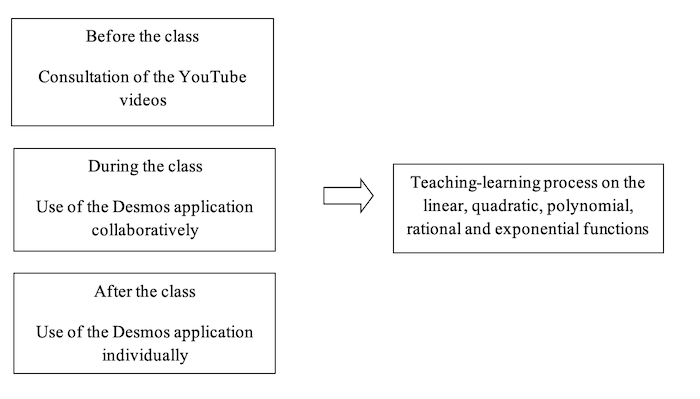
The activities before the class allowed the students to acquire the information from their courses through the use of technology (Lin et al., 2019). In particular, the flipped classroom proposes the consultation of videos and digital readings at home (Altas & Mede, 2021). Therefore, the hypotheses about the use of the flipped classroom before the face-to-face sessions are:
During the realisation of the flipped classroom, students participated actively in the classroom (Djamaa, 2020). Also, technological applications allowed supporting the learning process during the face-to-face sessions (Altas & Mede, 2021). Therefore, the hypothesis about the use of the flipped classroom during the face-to-face sessions is:
Technological advances allow students to have a central role during the learning process after the class (Djamaa, 2020). In fact, students use technological applications to facilitate the learning process during the flipped classroom (Altas & Mede, 2021). Therefore, the hypothesis about the use of the flipped classroom after the face-to-face sessions is:
The predictive models about the use of flipped classrooms in the teaching-learning process are:
Data collection was performed at the end of the functions unit in a Mexican university during the 2017 school year. The measurement instrument (a questionnaire) consisted of seven close-ended questions (see Table 2).
Table 2: Questionnaire about the Use of Flipped Classroom
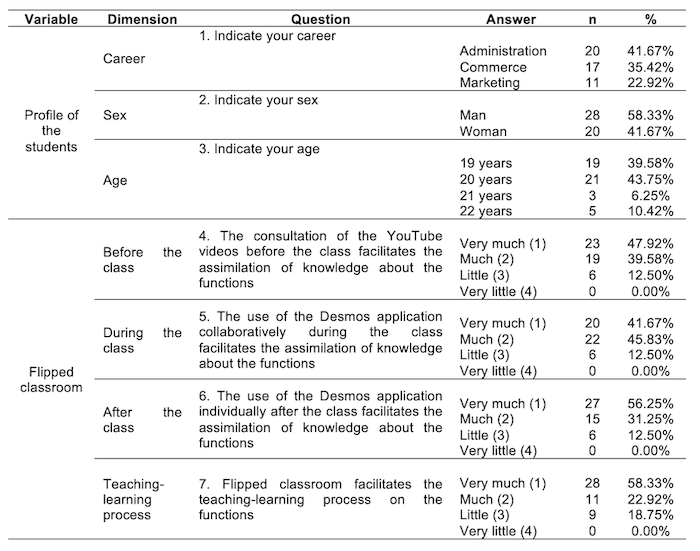
The values of Load Factor (> 0.500), Cronbach's Alpha (> 0.600) and Composite Reliability (> 0.700) are necessary to validate the questionnaire. Table 3 shows that the values of the Load Factor (> 0.740), Cronbach's Alpha (> 0.800) and Composite Reliability (> 0.870) allow validating the questionnaire about the use of the flipped classroom.
Table 3: Validation of the Questionnaire about the Flipped Classroom

The Rapidminer tool allowed the calculation of linear regression (machine learning) to analyse the perception of the students about the use of the flipped classroom and technological tools in the functions unit (see Figure 2). In the machine learning technique, the independent variables are the consultation with the YouTube videos about functions and use of the Desmos application. The dependent variable is the teaching-learning process on the functions.

The training section uses 70%, 80% and 90% of the sample to evaluate the research hypotheses about the use of the flipped classroom in the functions unit by means of linear regressions, and the evaluation section uses 30%, 20% and 10% of the sample to determine the accuracy of these linear regressions by means of the squared error.
Similarly, the Rapidminer tool allows for the construction of three predictive models about the use of the flipped classroom during the teaching-learning process on the functions through the decision tree technique. The information about the profile of the students and activities before, during and after the face-to-face sessions was used for the creation of these predictive models. The target variable was the teaching-learning process on the functions.
Finally, the neural network technique with 70%, 80% and 90% of the sample allowed for identifying how the consultation with YouTube videos before the class, and use of the Desmos application collaboratively during the class, and individually after the class, influenced the teaching-learning process in the functions unit through the Rapidminer tool.
Analysis showed that flipped classroom facilitates very much (n = 28, 58.33%), much (n = 11, 22.92%) and little (n = 9, 18.75%) the teaching-learning process on the functions (see Table 2). Likewise, the results of the machine learning technique indicate that the consultation with the YouTube videos before the class, use of the Desmos application collaboratively during the class and use of the Desmos application individually after the class, positively influenced the teaching-learning process on the functions (see Table 4).
Table 4: Results of the Machine Learning Technique
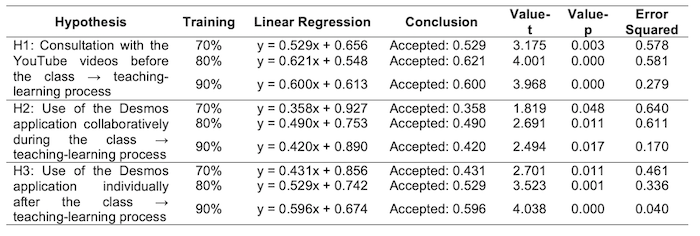
Table 2 indicates that the consultation with YouTube videos before the class facilitates very much (n = 23, 47.92%), much (n = 19, 39.58%) or little (n = 6, 12.50%) in the assimilation of knowledge about the functions. The results of the machine learning technique with 70% (0.529, value-t = 3.175, value-p = 0.003), 80% (0.621, value-t = 4.001, value-p = 0.000) and 90% (0.600, value-t = 3.968, value-p = 0.000) of the sample indicate that H1 is accepted (see Table 4). Therefore, the consultation with the YouTube videos before the class positively influenced the teaching-learning process on the functions.
Table 2 indicates that the use of the Desmos application collaboratively during the class facilitates very much (n = 20, 41.67%), much (n = 22, 45.83%) or little (n = 6, 12.50%) the assimilation of knowledge about the functions. The results of the machine learning technique with 70% (0.358, value-t = 1.819, value-p = 0.048), 80% (0.490, value-t = 2.691, value-p = 0.011) and 90% (0.420, value-t = 2.494, value-p = 0.017) of sample indicate that H2 is accepted (see Table 4). Therefore, the use of the Desmos application collaboratively during the class positively influenced the teaching-learning process on the functions.
Table 2 indicates that the use of the Desmos application individually after the class facilitates very much (n = 27, 56.25%), much (n = 15, 31.25%) or little (n = 6, 12.50%) the assimilation of knowledge about the functions. The results of the machine learning technique with 70% (0.431, value-t = 2.701, value-p = 0.011), 80% (0.529, value-t = 3.523, value-p = 0.001) and 90% (0.596, value-t = 4.038, value-p = 0.000) of the sample indicate that H3 is accepted (see Table 4). Therefore, the use of the Desmos application individually after the class positively influenced the teaching-learning process on the functions.
Table 5 shows twelve conditions of the PM1 with an accuracy of 77.07%. For example, if the student thought that the consultation with the YouTube videos before the class facilitated very much the assimilation of knowledge about the functions and took the career of Administration, then the flipped classroom facilitated very much the teaching-lea
Table 5: Conditions of the PM1
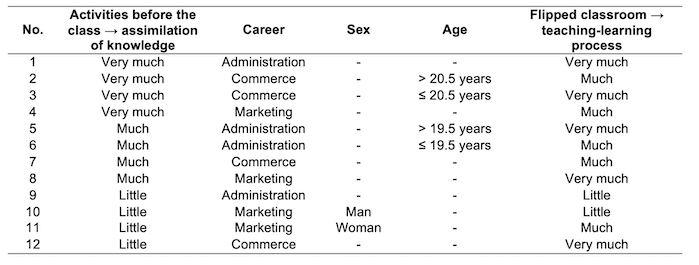
Table 6 shows thirteen conditions of the PM2 with an accuracy of 75.00%. For example, if the student thought that the use of the Desmos application collaboratively during the class facilitated very much the assimilation of knowledge about the functions, was a woman and took the career of Commerce, then the flipped classroom facilitated very much the teaching-learning process on the functions.
Table 6: Conditions of the PM2
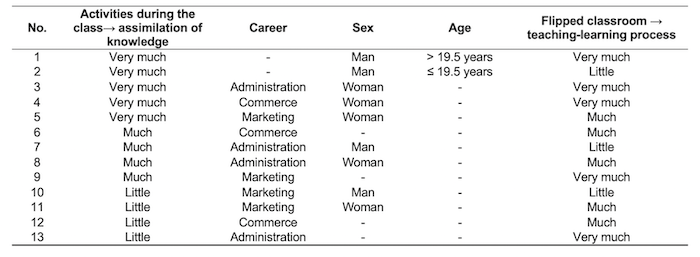
Table 7 shows fourteen conditions of the PM3 with an accuracy of 83.33%. For example, if the student thought that the use of the Desmos application individually after the class facilitated very much the assimilation of knowledge about the functions and took the career of Administration, then the flipped classroom facilitated very much the teaching-learning process on the functions.
Table 7: Conditions of the PM3
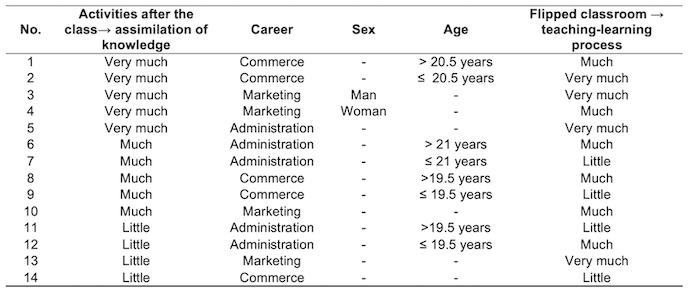
Finally, the results of the neural network with 70% (1.000), 80% (1.000) and 90% (0.401) of the sample indicate that the use of the Desmos application collaboratively during the class significantly influences the teaching-learning process about the functions (see Table 8).
Table 8: Results of the Neural Network Technique

Several authors (e.g., Cabi, 2018; Shih et al., 2019) have mentioned that the flipped classroom is a pedagogical model that facilitates the teaching-learning process through the incorporation of technology in school activities. For example, 58.33% of the students thought that the flipped classroom facilitated very much the teaching-learning process on the functions. In the Basic Mathematics course, the consultation with YouTube videos about functions and use of the Desmos application provoked the active participation of the students during the educational process. Also, the flipped classroom facilitated much (n = 11, 22.92%) the teaching-learning process on the functions. Therefore, most of the students had a favourable opinion about the use of this pedagogic model in the field of mathematics.
This research confirms the findings of various authors (e.g., Karabulut-Ilgu et al., 2018) about the role of videos in the educational field to promote personalised learning. Educational institutions use YouTube videos to create virtual learning spaces for the field of mathematics (Insorio & Macandog, 2022). In particular, 47.92% of the students thought that the consultation with the YouTube videos before the class facilitated very much the assimilation of knowledge about the functions. Before the face-to-face sessions, the students in Marketing, Commerce and Administration acquired their knowledge about linear, quadratic, polynomial, rational and exponential functions through this multimedia resource. Also, the consultation with the YouTube videos before the class facilitated much (n = 19, 39.58%) the assimilation of knowledge about the functions. Thus, most of the students (87.50%) had a favourable opinion about the use of this technological tool.
Similar to Aydin et al. (2021) and Cabi (2018), the incorporation of videos in school activities facilitated learning at home. The YouTube videos allow for students to learn mathematical topics in a fun way from anywhere (Insorio & Macandog, 2022). The results of the machine learning technique about H1 are greater than 0.520 and value-p < 0.050, therefore, the consultation with the YouTube videos before the class positively influenced the teaching-learning process on the functions.
Data science identifies twelve conditions of the PM1 with an accuracy of 77.07%. In this predictive model, the career, sex and age of the students determining how consultation with the YouTube videos before the class influenced the teaching-learning process in the functions unit.
The flipped classroom allows organising and carrying out the educational process with the support of digital tools (Long et al., 2019). According to Rojas-Maldonado (2019), the Desmos application is an ideal tool to facilitate the teaching-learning process about mathematics. In particular, 45.83% of the students thought that the use of the Desmos application collaboratively during the class facilitated much the assimilation of knowledge about the functions. In the Basic Mathematics course, this web application assisted students to actively participate in solving the exercises during the face-to-face sessions. Also, the use of the Desmos application collaboratively during the class facilitated very much (n = 20, 41.67%) the assimilation of knowledge about the functions. Thus, most of the students (87.50%) had a favourable opinion.
In addition, this study shares the ideas of various authors (e.g., Aydin et al., 2021; Drozdikova-Zaripova & Sabirova, 2020) about the use of ICTs in the classroom to improve learning in the flipped classroom modality. As mentioned by Rojas-Maldonado (2019), educators can use the Desmos application to understand topics related to mathematics. The results of the machine learning technique about H2 are greater than 0.350 and value-p < 0.050, therefore, the use of the Desmos application collaboratively during the class positively influenced the teaching-learning process on the functions.
Data science identifies thirteen conditions of the PM2 with an accuracy of 75.00%. In this predictive model, the career, sex and age of the students determined how the use of the Desmos application collaboratively influenced the teaching-learning process in the functions unit.
The flipped classroom allows students to actively participate after the class through the use of technology (Lin et al., 2019). The Desmos application facilitates the creation of educational spaces in the field of mathematics (Rojas-Maldonado, 2019). For example, 56.25% of the students thought that the use of the Desmos application individually after the class facilitated very much the assimilation of knowledge about the functions. After the face-to-face sessions, the students used this web application to verify the results of the exercises about maximum and minimum points, domain and range. Also, the use of the Desmos application individually after the class facilitated much (n = 15, 31.25%) the assimilation of knowledge about the functions. Thus, most of the students (87.50%) had a favourable opinion.
As Altas and Mede (2021) indicated, the use of technology in the flipped classroom allows the active role of students at any time. The results of the machine learning technique about H3 are greater than 0.430 and value-p < 0.050, therefore, the use of the Desmos application individually after the class positively influenced the teaching-learning process on the functions.
Data science identifies fourteen conditions of the PM3 with an accuracy of 83.33%. In this predictive model, the career, sex and age of the students determined how the use of the Desmos application individually influenced the teaching-learning process in the functions unit.
On the other hand, the neural network indicated that the use of the Desmos application collaboratively during the class significantly influenced the teaching-learning process about the functions. Finally, the realisation of the school activities before, after and during the face-to-face sessions improved the teaching-learning conditions through the use of technology (Stratton et al., 2020).
Teachers have the opportunity to innovate the educational process through the use of pedagogical and technological models. In particular, the flipped classroom promotes the use of digital tools during the planning and performance of school activities outside and inside the classroom. This quantitative research implemented the flipped classroom through consultation with YouTube videos before the class and use of the Desmos application collaboratively during the class and, individually, after the class.
Educational institutions incorporate flipped classrooms to improve teaching-learning conditions. In the Basic Mathematics course, the consultation with YouTube videos before the class, use of the Desmos application collaboratively during the class and use of the Desmos application, individually, after the class positively influenced the teaching-learning process on the functions. The decision tree technique identified three predictive models about the use of the flipped classroom in the field of mathematics, with an accuracy higher than 77.00%. On the other hand, the neural network technique indicates that the use of the Desmos application in a collaborative way during the class significantly influenced the teaching-learning process in the functions unit.
The limitations of this research are the size of the sample, perception of the students, use of the Desmos application and consultation with YouTube videos during the teaching-learning process about the functions. Therefore, future research could implement the flipped classroom by considering online questionnaires, digital games and social networks in various educational institutions. Additionally, data collection could include the perceptions of students and educators about the use of this pedagogical model for the development of skills, academic performance and motivation.
The implications of this research are that universities could update courses and carry out creative school activities outside and inside the classroom through the flipped classroom. In addition, teachers could use free web applications, such as the Desmos application, to improve learning conditions and encourage participation at any time.
This mixed study recommends the use of data science, with the support of machine learning algorithms, to discover new information related to the use of technology in the educational field through the analysis, classification and evaluation of educational phenomena.
Finally, the flipped classroom facilitates the active role of students during the learning process, promotes the construction of new educational virtual spaces and allows for the improvement of the educational process through the incorporation of technological tools before, after and during face-to-face sessions.
Ayyagari, R., Grover, V., & Purvis, R. (2011). Technostress: Technological antecedents and ımplications. MIS Quarterly, 35(4), 831. https://doi.org/10.2307/41409963
Bambaeeroo, F., & Shokrpour, N. (2017). The impact of the teachers' non-verbal communication on success in teaching. Journal of Advances in Medical Education & Professionalism, 5(2), 51-59.
Beames, J.R., Christensen, H., & Werner-Seidler, A. (2021). School teachers: The forgotten frontline workers of Covid-19. Australasian Psychiatry: Bulletin of Royal Australian and New Zealand College of Psychiatrists, 29(4), 420-422.
Buluş, M., Atan, A., & Erten Sarıkaya, H. (2017). Effective communication skills: A new conceptual framework and scale development study. International Online Journal of Educational Sciences, 9(2), 575-590.
Buss, D.M. (2000). The evolution of happiness. American Psychologist, 55(1), 15-23.
Chih-Yuan Sun, J., & Rueda, R. (2012). Situational interest, computer self-efficacy and self-regulation: Their impact on student engagement in distance education. British Journal of Educational Technology, 43(2), 191-204.
Dağlı, A., & Baysal. N. (2016). Adaptation of the Satisfaction with Life Scale into Turkish: The study of validity and reliability. Electronic Journal of Social Sciences, 15(59), 1250-1262.
de Carvalho, J.S., Oliveira, S., Roberto, M.S., Gonçalves, C., Bárbara, J.M., de Castro, A.F. (2021). Effects of a mindfulness-based ıntervention for teachers: A study on teacher and student outcomes. Mindfulness, 12, 1719-1732.
Deniz, M.E., Erus, S.M., & Batum, D. (2020). Examining marital satisfaction in terms of interpersonal mindfulness and perceived problem solving skills in marriage. International Online Journal of Educational Sciences, 12(2), 69-83.
Diener, E. (1984). Subjective well-being. Psychological Bulletin, 95(3), 542-575.
Diener, E., Emmons, R.A., Larsen, R.J., & Griffin, S. (1985). The satisfaction with life scale. Journal of Personality Assessment, 49(1), 71-75.
Duncan, L.G. (2007). Assessment of mindful parenting among parents of early adolescents: Development and validation of the interpersonal mindfulness in parenting scale. [Unpublished Doctoral Dissertation, Pennsylvania State University.]
Erus, S.M., & Tekel, E. (2020). Development of Interpersonal Mindfulness Scale-TR (IMS-TR): A validity and reliability study. European Journal of Educational Research, 9(1), 103-115.
Flook, L., Goldberg, S.B., Pinger, L., Bonus, K., & Davidson, R.J. (2013). Mindfulness for teachers: A pilot study to assess effects on stress, burnout, and teaching efficacy. Mind, Brain & Education, 7(3), 182-195.
Frank, J.L., Jennings, P.A., & Greenberg, M.T. (2016). Validation of the Mindfulness in Teaching Scale. Mindfulness, 7(1), 155-163.
Gençöz, T. (2000). Positive and negative affect schedule: A study of validity and reliability. Turkish Journal of Psychology, 15(46), 19-26.
Hammerness, K., Darling-Hammond, L., & Bransford, J. (2012). How teachers learn and develop. In L. Darling-Harmond & J. Bransford (Eds.), Preparing teachers for a changing world: What teachers should learn and be able to do. Jossey-Bass, 358-389.
Henriksen, D., Gruber, N., & Woo, L. (2022). Looking to the future from the present: A call for well-being and mindfulness in education. Journal of Technology and Teacher Education, 30(2), 145-154.
Hwang, Y.S., Bartlett, B., Greben, M., & Hand, K. (2017). A systematic review of mindfulness interventions for in-service teachers: A tool to enhance teacher wellbeing and performance. Teaching and Teacher Education, 64, 26-42.
Kabat-Zinn, J. (1994). Wherever you go, there you are: Mindfulness meditation in everyday life. Hyperion.
Kohlenberg, R.J., Tsai, M., Kuczynski, A.M., Rae, J.R., Lagbas, E., Lo, J., & Kanter, J.W. (2015). A brief, interpersonally oriented mindfulness intervention incorporating: Functional Analytic Psychotherapy׳s model of awareness, courage and love. Journal of Contextual Behavioral Science, 4(2), 107-111.
Kozlowski, A. (2013). Mindful mating: Exploring the connection between mindfulness and relationship satisfaction. Sexual and Relationship Therapy, 28(1-2), 92-104.
Lomas, T., Medina, J.C., Ivtzan, I., Rupprecht, S., & Eiroa-Orosa, F.J. (2017). The impact of mindfulness on the wellbeing and performance of educators: A systematic review of the empirical literature. Teaching and Teacher Education, 61, 132-141.
Lyubomirsky, S., King, L., & Diener, E. (2005). The benefits of frequent positive affect: Does happiness lead to success? Psychological Bulletin, 131(6), 803-855.
Ma, Y., Wang, F., & Cheng, X. (2021). Kindergarten teachers’ mindfulness in teaching and burnout: The mediating role of emotional labor. Mindfulness 12(3), 722-729.
MacKinnon, D.P. (2008). Introduction to statistical mediation analysis. Routledge.
McMillan, J.H., & Schumacher, S. (2006). Research in education: Evidence-based inquiry. Pearson Higher Ed.
Molloy Elreda, L., Jennings, P.A., DeMauro, A.A. Mischenko, P.P., & Brown, J.L. (2019). Protective effects of ınterpersonal mindfulness for teachers’ emotional supportiveness in the classroom. Mindfulness, 10(3), 537-546. https://doi.org/10.1007/s12671-018-0996-y
Oberle, E., & Schonert-Reichl, K.A. (2016). Stress contagion in the classroom? The link between classroom teacher burnout and morning cortisol in elementary school students. Social Science & Medicine, 159, 30-37. https://doi.org/10.1016/j.socscimed.2016.04.031
Pratscher, S.D., Rose, A.J., Markovitz, L., & Bettencourt, A. (2018). Interpersonal mindfulness: Investigating mindfulness in interpersonal interactions, co-rumination, and friendship quality. Mindfulness, 9(4), 1206-1215.
Pratscher, S.D., Wood, P.K., King, L.A., & Bettencourt, B.A. (2019). Interpersonal mindfulness: Scale development and initial construct validation. Mindfulness, 10(6), 1044-1061.
Preacher, K.J., & Hayes, A.F. (2004). SPSS and SAS procedures for estimating indirect effects in simple mediation models. Behavior Research Methods, Instruments, & Computers, 36(4), 717-731.
Preacher, K.J., & Hayes, A.F. (2008). Asymptotic and resampling strategies for assessing and comparing indirect effects in multiple mediator models. Behavior Research Methods, 40(3), 879-891.
Sokal, L., & Eblie Trudel, L. (2020). How to prevent teacher burnout during the coronavirus pandemic. The Conversation. https://theconversation.com/how-to-prevent-teacher-burnout-during-the-coronavirus-pandemic-139353.
Stahl, B., & Goldstein, E. (2010). A mindfulness-based stress reduction workbook. A New Harbinger Publication.
Tabachnick, B.G., & Fidell, L.S. (2013). Using multivariate statistics: International edition. Pearson.
Tarrasch, R., Berger, R., & Grossman, D. (2020). Mindfulness and compassion as key factors in improving teacher’s well being. Mindfulness 11, 1049-1061.
Tuan, L.T. (2022). Employee mindfulness and proactive coping for technostress in the COVID-19 outbreak: The roles of regulatory foci, technostress, and job insecurity. Computers in Human Behavior, 129, 107148. https://doi.org/10.1016/j.chb.2021.107148
Watson, D., Clark, L.A., & Tellegen, A. (1988). Development and validation of brief measures of positive and negative affect: The PANAS scales. Journal of Personality and Social Psychology, 54, 1063-1070.
Wrede, S.J., Esch, T., & Michaelsen, M.M. (2023). Mindfulness in the digital workplace: An explorative study of the compatibility of mindfulness and technology. Research Square (pre-print). https://doi.org/10.21203/rs.3.rs-2459776/v1
Zarate, K., Maggin, D.M., & Passmore, A. (2019). Meta-analysis of mindfulness training on teacher well-being. Psychology in the Schools, 56, 1700-1715.
Author
Ricardo-Adán Salas-Rueda is a full time researcher in the Instituto de Ciencias Aplicadas y Tecnología, Universidad Nacional Autónoma de México. Email: ricardo.salas@icat.unam.mx (Orcid: https://orcid.org/0000-0002-4188-4610)
Cite this paper as: Salas-Rueda, R-A. (2023). Perception of students about the effectiveness of the flipped classroom and technological tools in the learning of mathematics. Journal of Learning for Development, 10(3), 376-391.